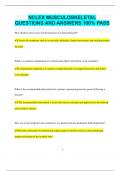Exam (elaborations)
NCLEX MUSCULOSKELETAL QUESTIONS AND ANSWERS 100% PASS
- Course
- Institution
NCLEX MUSCULOSKELETAL QUESTIONS AND ANSWERS 100% PASS How should a nurse assess for the presence of a dislocated joint? Assess for symptoms such as severe pain, deformity, limited movement, and swelling around the joint. What is a common complication of a fracture that affects blood flow...
[Show more]



